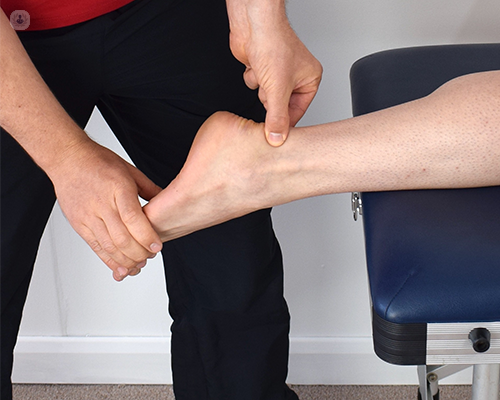How ankle arthritis is diagnosed and treated (and if your ankle will need replacing)
Escrito por:If your ankle feels stiff, swollen and painful, you might be wondering if you have arthritis. To treat ankle arthritis, you’ll first need to get it diagnosed by a specialist.
The treatment of ankle arthritis is one of renowned consultant orthopaedic surgeon, Mr Henry Willmott’s, areas of expertise. Learn from him about how ankle arthritis is diagnosed and managed, as well as if ankle surgery might be an option to improve your quality of living.

What does ankle arthritis feel like?
Arthritis of the ankle causes pain that is worse after walking or physical activity, and that is often felt at night. Patients with arthritis of the ankle may also notice stiffness, loss of movement and swelling around the ankle.
How is ankle arthritis diagnosed?
In the first instance, a thorough history and examination is important. As a specialist, I would ask about:
- A history of trauma or injury
- The longevity of the symptoms
- Any exacerbating features
An examination may reveal:
- Deformity
- Loss of movement
- Tenderness across the joint line
- Instability of the ankle
It is important to differentiate ankle arthritis form arthritis of the other joints in the foot. To do this, weight-bearing X-rays are the first line of investigation. These can usually be done in the clinic at the same time as the initial consultation.
Further details of the nature and severity of the arthritis (as well as investigations into any other potential causes of ankle pain) may require a CT scan or an MRI scan.
What causes arthritis in your ankle?
The commonest cause of ankle arthritis is previous trauma. This trauma could be several innocuous minor injuries or a significant fracture several years ago. In some cases, no cause is found, although often there is a genetic or familial component. Conditions such as inflammatory joint disease or rheumatoid arthritis can also result in arthritis of the ankle.
What is the first line-treatment for ankle arthritis?
For the majority of cases, simple lifestyle changes are sufficient treatment, such as:
1. Weight loss.
2. Avoidance of high impact sporting activities such as running (non-impact sports such as swimming, cycling or using the cross trainer or rowing machine are kinder to the ankles).
3. Supportive footwear.
4. Simple painkillers (such as paracetamol and anti-inflammatories).
Physiotherapy can also help strengthen the muscles around the ankle joint and preserving the range of movement. If these measures are insufficient, a steroid injection into the joint may reduce symptoms.
Will I need my ankle replaced if I have ankle arthritis?
Two principal surgical treatments can be considered when all non-operative measures are exhausted: ankle fusion and ankle replacement.
Ankle fusion
Ankle fusion is an operation to permanently join the tibia to the ankle bone, eliminating the up and down movement at the joint. It is an operation that reliably eliminates pain and has a low complication rate. It can usually be done using keyhole surgery, which reduces wound complications. The loss of movement at the ankle does mean that running and very brisk walking are difficult, but for normal activity, it is a very good option.
Ankle replacement
Ankle replacement is more complicated, but aims to maintain the range of movement of the ankle whilst also reducing pain. If there is a significant deformity in the ankle or the bone has been damaged by the arthritic process, ankle replacement may not be possible. When compared to a fusion, the complication rate and risk of ongoing pain are slightly higher than with an ankle replacement, but walking pattern and function in the medium-term may be better. The downside of an ankle replacement is that it will eventually wear out, so it may not be the best option for very active or younger patients.
Are you worried about your ankle? Don't hesitate to visit Mr Henry Willmott’s profile to learn how he can help you.


